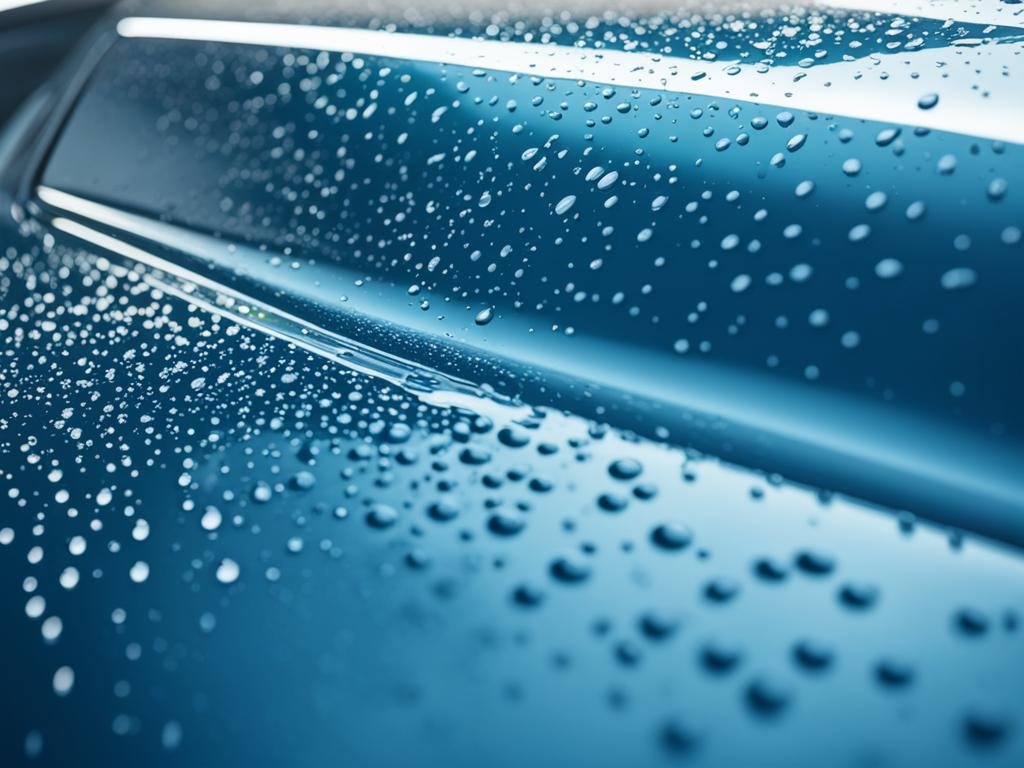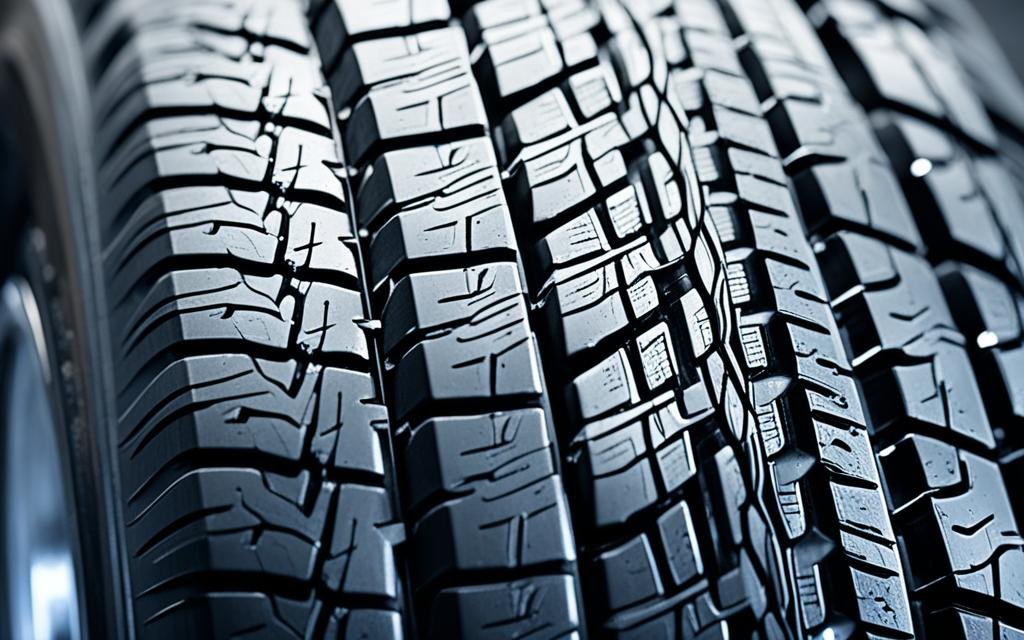
Serving Norfolk and Oxford counties, we bring the shine to you. From sedans to SUVs, experience unmatched convenience and quality right at your doorstep. Trust us to make your vehicle dazzle. Call now and let your car shine!
Key Takeaways:
- Learn how to use paint sealant for long-lasting protection and a pristine finish.
- Discover the step-by-step process and best practices for applying paint sealant.
- Understand the benefits of using paint sealant, including resistance against contaminants and increased value.
- Choose between professional paint sealant application or DIY methods.
- Experience the convenience of having your vehicle detailed at your own location.
What is a Paint Sealant?
A paint sealant is a synthetic chemical product that is specifically designed to protect vehicles’ clear coat. It acts as a sacrificial barrier against various elements that can damage the paint, including dirt, road contaminants, UV rays, moisture, and acidic substances. By applying a paint sealant, you can ensure that your car’s paint stays protected and maintains its shine for a longer period.
One of the key benefits of a paint sealant is its hydrophobic properties. This means that it repels water, preventing it from sticking to the surface of the paint. As a result, water droplets bead up and roll off the car more easily. This not only makes your car look cleaner but also reduces the effort required to clean it.
Paint sealants typically contain a combination of synthetic ingredients such as polymers and resins. These ingredients work together to create a durable protective layer on the paint’s surface. While the specific composition of paint sealants may vary between manufacturers, the goal remains the same: to provide long-lasting protection and enhance the appearance of your vehicle.
“A paint sealant creates a sacrificial barrier on the clear coat, protecting the paint from dirt, contaminants, UV rays, moisture, and acidic substances.”
By using a paint sealant, you can enjoy several benefits for your vehicle. Here are some of the key advantages:
- Protection against UV rays: Paint sealants shield the paint from harmful UV rays that can cause fading and oxidation.
- Defense against contaminants: The protective layer of a paint sealant prevents dirt, dust, and other contaminants from bonding to the paint, making it easier to wash off.
- Enhanced appearance: A paint sealant can give your car a sleek and glossy look, enhancing its overall appearance.
- Long-lasting results: With its durable formulation, a paint sealant provides long-lasting protection, reducing the need for frequent reapplication.
Table: Comparing Paint Sealant Benefits
| Benefit | Paint Sealant | Alternative Products |
|---|---|---|
| Protection against UV rays | Yes | No |
| Resistance to contaminants | Yes | No |
| Enhanced appearance | Yes | No |
| Long-lasting results | Yes | No |
How Do Paint Sealants Work?
Paint sealants play a crucial role in protecting and enhancing the appearance of your vehicle’s paint. They come in different forms such as paste, liquid, or spray to cater to various application preferences. Whether you choose to apply them using a random orbital polisher or by hand, paint sealants create a strong bond with the clear coat, providing long-lasting durability and protection against UV radiation and chemicals.
When it comes to the formulation of paint sealants, you’ll find both solvent-based and water-based options. Solvent-based sealants use a petroleum-based solvent, which may emit volatile organic compounds (VOCs) during application. On the other hand, water-based sealants are dissolved in water, offering a safer and more environmentally-friendly alternative.
One of the key ingredients found in paint sealants is amino-functional silicone oil. This silicone compound enables the sealant to create cross-links with the clear coat, forming a protective barrier that shields the paint from contaminants and weather elements. Not only do paint sealants provide excellent bonding and protection, but they also enhance the visual appearance of the paint, giving it a glossy and vibrant finish.
Paint sealants are designed to withstand the test of time. They offer impressive durability, allowing your vehicle’s paint to maintain its shine and protection for an extended period. With regular application and proper maintenance, paint sealants can keep your car looking its best, even in harsh weather conditions.
Here is a visually appealing and informative table summarizing the different characteristics of paint sealants:
| Form | Application Method | Chemical Composition | Durability | Visual Enhancement |
|---|---|---|---|---|
| Paste | Applied with a microfiber sponge | Amino-functional silicone oil, polymers, and resins | Long-lasting | Glossy and vibrant finish |
| Liquid | Applied with a random orbital polisher | Amino-functional silicone oil, polymers, and resins | Long-lasting | Glossy and vibrant finish |
| Spray | Applied directly onto the surface | Amino-functional silicone oil, polymers, and resins | Long-lasting | Glossy and vibrant finish |
Now that you have a better understanding of how paint sealants work and their benefits, let’s move on to the next section and explore how long these sealants typically last and the factors that can affect their longevity.
How Long Do Paint Sealants Last?
Paint sealants provide long-lasting protection for your vehicle’s paint, helping to maintain its shine and integrity. However, the longevity of paint sealants can vary depending on several factors.
Factors Affecting Longevity
Several factors can affect how long a paint sealant lasts on your vehicle:
- Storage Conditions: The way your vehicle is stored, whether it’s kept in a garage or exposed to the elements, can impact the longevity of the paint sealant.
- Mileage: The amount of mileage your vehicle accumulates can influence how long the paint sealant lasts. Vehicles that are driven more frequently may require more frequent reapplication.
- Weather Conditions: Extreme weather conditions, such as harsh sunlight, heavy rain, or snow, can accelerate the wear and degradation of paint sealants.
- Paint Preparation: Proper paint preparation, including thorough cleaning and paint correction, can enhance the adherence and durability of the paint sealant.
- Washing Frequency: The frequency of washing your vehicle can impact the lifespan of the paint sealant. Frequent washing may require more frequent reapplication.
- Shampoo Type: The type of shampoo used during the car wash can affect the longevity of the paint sealant. Using a pH-balanced shampoo specifically designed for paint protection can help prolong its effectiveness.
- Reapplication: Paint sealants typically need to be reapplied before the previous coat wears off. Reapplication is generally recommended once every season, or approximately four times a year.
By considering these factors and taking the necessary steps to maintain and reapply the paint sealant accordingly, you can maximize its longevity and ensure optimal protection for your vehicle’s paint finish.
When it’s time to reapply the paint sealant, a good indication is the appearance of water beading and sheeting on the surface. This suggests that the sealant’s hydrophobic properties may be diminishing, and it’s time for a fresh application.
Frequently Asked Questions
Q: Can paint sealants last longer than 6 months?
A: While paint sealants generally last between 3 to 6 months, some high-quality sealants may offer extended protection, potentially lasting up to a year. However, this can vary depending on the factors mentioned earlier.
Q: Can I apply paint sealant over wax?
A: It’s generally recommended to apply paint sealant to clean, bare paint surfaces. Applying it over wax may hinder its bonding capabilities and overall effectiveness. It’s best to remove any existing wax before applying paint sealant.
Q: Can I top my paint sealant with wax?
A: Yes, topping the paint sealant with wax can provide additional protection and enhance the shine. However, ensure that the sealant has fully cured before applying the wax.
Comparing Paint Sealant Longevity
| Paint Sealant Brand | Longevity |
|---|---|
| Brand A Paint Sealant | 3-4 months |
| Brand B Paint Sealant | 4-5 months |
| Brand C Paint Sealant | 5-6 months |
Note: The table above provides a general comparison of different paint sealant brands and their average longevity. Actual results may vary depending on various factors.
Understanding the factors that affect the longevity of paint sealants and following proper maintenance practices can help you make informed decisions on reapplication and ensure long-lasting protection for your vehicle’s paint finish.

How to Apply Paint Sealant
When it comes to applying paint sealant, there are a few methods you can choose from: using a random orbital polisher, a forced random orbital polisher, or simply applying it by hand. The goal is to achieve a thin and even application for optimal results.
If you opt for a random orbital polisher, it’s important to select the appropriate pad and speed setting to ensure a smooth application. Start by applying a small amount of paint sealant to the pad, then spread it evenly onto the vehicle’s surface using slow, overlapping motions. This method ensures an even distribution of the product and minimizes the risk of swirl marks.
A forced random orbital polisher can be used for larger vehicles or when you need to cover a larger area. Follow a similar technique as with the random orbital polisher, applying the sealant in controlled and overlapping passes for a thin and uniform layer.
If you prefer the traditional method, applying paint sealant by hand is also an option. Put a small amount of sealant onto a foam applicator pad or a soft microfiber cloth, then apply it in gentle, circular motions. Work in small sections at a time to ensure thorough coverage.
After applying the paint sealant, it’s essential to let it cure for the recommended amount of time. Cure times may vary, but typically range from 1 to 24 hours. Be sure to follow the instructions provided by the manufacturer for the best results.
If desired, you can apply multiple coats of paint sealant for enhanced protection. However, it’s crucial to allow each coat to cure fully before applying the next. Layering the sealant provides additional durability and ensures complete coverage.
“For a professional finish, consider topping the cured paint sealant with a layer of wax. This added step can enhance the appearance of your vehicle and offer additional protection against the elements.”
Product Recommendations for Paint Sealants
When it comes to applying paint sealants, having the right products and tools is essential for achieving optimal results. Whether you prefer the convenience of a random orbital polisher, the precision of a forced random orbital polisher, or the simplicity of hand application, there are options available to suit your preference. Here are our top product recommendations for paint sealants:
| Product | Type | Features |
|---|---|---|
| Random Orbital Polisher | Machine | Efficient application, consistent results |
| Forced Random Orbital Polisher | Machine | Precise control, reduced risk of swirl marks |
| Hand Applicator | Manual | Easy to use, suitable for smaller areas |
One highly recommended paint sealant product is Mirror Shine. Known for its exceptional hydrophobic properties, Mirror Shine creates a protective barrier that repels water and keeps your vehicle looking clean for longer periods. Its anti-static formula also helps to reduce dust buildup, making maintenance a breeze.
In addition to dedicated paint sealants, there are also wax sealants available, which combine the durability of traditional paint sealants with the deep shine of traditional waxes. These hybrid wax sealants provide enhanced protection and a glossy finish, giving your vehicle a stunning appearance. Wax sealants can be a great choice for those who want to achieve both long-lasting results and a high level of visual enhancement.
With these product recommendations, you can confidently choose the right tools and sealants to achieve professional-quality results when applying paint sealants. Remember to follow the manufacturer’s instructions for each product and enjoy the many benefits of long-lasting protection and enhanced aesthetics for your vehicle.
Conclusion
Applying paint sealant is a crucial step in maintaining the protection and shine of your vehicle’s paintwork. With its easy application and long-lasting results, paint sealant provides a durable barrier against UV rays, contaminants, and other damaging elements.
By using paint sealant, you not only enhance the appearance of your car but also make it easier to maintain. The hydrophobic properties of paint sealants repel water and prevent dirt and grime from sticking to the surface. This means less time spent cleaning and more time enjoying your vehicle’s polished look.
In addition to its practical benefits, paint sealant also offers an aesthetic advantage. It gives your car a high-gloss shine that enhances its overall appearance, making it stand out on the road. Whether you’re a car enthusiast or simply want to keep your vehicle looking its best, paint sealant is a valuable investment.
To ensure the longevity of the paint sealant’s effects, it’s recommended to follow the proper application and reapplication techniques. By doing so, you can enjoy the protection, shine, and easy maintenance that paint sealant provides for months to come.
FAQ
How do I use paint sealant?
To use paint sealant, start by washing and drying your vehicle thoroughly. Then, apply the sealant using a microfiber sponge, spreading it thinly and evenly across the surface. Finally, buff the surface with a synthetic cloth to enhance the shine. For more detailed instructions, refer to our step-by-step paint sealant guide.
What is a paint sealant?
Car paint sealant is a synthetic chemical product applied on the clear coat of a vehicle to create a sacrificial barrier against dirt, road contaminants, UV exposure, moisture, and acidic substances. It offers hydrophobic properties that repel water and make the paint easier to clean.
How do paint sealants work?
Paint sealants come in paste, liquid, or spray form and are typically applied with a random orbital polisher or by hand. They bond with the clear coat, creating cross-links and a protective barrier. Paint sealants offer durability, protection against UV radiation and chemicals, and enhance the visual appearance of the paint.
How long do paint sealants last?
Paint sealants can last between 3 to 6 months, depending on various factors including storage conditions, mileage, weather conditions, paint preparation, frequency of washing, and type of shampoo used. Reapplication is recommended before the previous coat wears off, typically once every season (4 times a year).
How do I apply paint sealant?
Paint sealant can be applied using a random orbital polisher, forced random orbital polisher, or by hand. The key is to spread the product as thinly and evenly as possible. Cure time varies but typically ranges from 1 to 24 hours. Multiple coats can be applied, but each coat should cure before applying the next. Layering and topping with wax can enhance the protection and aesthetics.
What are some recommended products for applying paint sealants?
Recommended products for applying paint sealants include random orbital polishers, forced random orbital polishers, and hand applicators. Mirror Shine is a recommended paint sealant known for its hydrophobic and anti-static properties. Wax sealants, also known as hybrid wax sealants, combine the durability of paint sealants with the deep shine of traditional waxes.
What are the benefits of applying paint sealant?
Applying paint sealant offers durable protection and a high-gloss shine for vehicles. It provides easier maintenance, protects against UV rays and contaminants, and enhances the appearance of the paint. With proper application and reapplication, paint sealant can maintain its benefits for several months, ensuring long-lasting results.
Source Links
RELATED POSTS
View all



